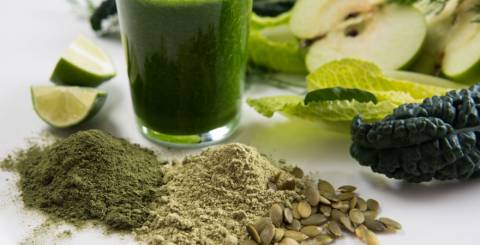How to Make a Healthy Smoothie for Weight Loss (Five Simple Steps)

Smoothies are a great breakfast option for packing in plenty of nutrients into your day. For weight loss, it’s all about what you put in them.
To make a smoothie a healthy complete meal, you want to formulate it with a balance of healthy foods to keep you feeling full until the next meal. When prepared appropriately, smoothies are great for fat loss because they give your body a super boost of nutrition and can help keep you away from choosing less healthy food over the day.
Follow these top pointers for building a healthy smoothie which trumps any sugar-loaded commercially prepared product.
1. Use vegetables as the base
Dark leafy greens and herbs are the everyday superfoods found in your kitchen. Makes vegetables the base of your breakfast smoothie for the nutrients and bulk-adding fibre.
If you have a powerful blender you can add just about any kind of vegetable. In less powerful blenders use courgette, beetroot (grated), cucumber, and leafy greens which are softer in texture.
Choose one to two handfuls of the following:
Dark leafy greens (spinach, silverbeet, kale etc.), courgette, broccoli, beetroot, carrot, or cucumber.
2. Limit fruit
Limit the fruit to no more than 1 cup. Fruit is naturally high in sugar and for anyone trying to drop belly weight, limiting sugar is a great place to start.
Berries are a good fruit of choice because of their low sugar content. Citrus fruits, especially lemon or lime add a good sharp flavour which balances the bitterness of vegetables.
Top low sugar fruit picks:
Berries, lemon, lime, kiwi, and seasonal fruit.
3. Add healthy fat
Using healthy fat is key for making your meal balanced and satisfying. It’s about getting the right balance of healthy fat for your individual needs. Too much fat can turn into and excess of calories preventing weight loss. Use just enough of these healthy fat additions to build a smoothie which will keep you full until lunch time.
Choose one healthy fat:
Avocado, coconut milk/cream, nut butter, linseed oil, Greek yoghurt, crushed nuts/seeds/coconut topping.
4. Add protein
Protein is also a key part of any healthy breakfast to keep you feeling satisfied and balancing blood sugar levels over the day. Protein needs are very individual, but usually between 15-30 grammes is enough for a meal. Check labels on food or use a tracking app to work out how much protein is in your smoothie recipe. Remember vegetables and some fats (yoghurt, buts) also act as a source of protein.
Top protein additions:
Natural protein powder (whey, pea, rice, hemp), Greek yoghurt, quinoa, nuts, seeds.
5. Choose your liquid
The purpose of adding liquid is mostly functional. Add enough liquid to make your smoothie blend and adjust according to how you think you like it.
The liquid in the smoothie does also add to your daily fluid intake which is a good bonus for anyone who struggles to drink enough later in the day. Another bonus is in choosing herbal teas or good quality coffee by providing antioxidants which are linked to numerous health benefits.
Liquids of choice:
Water, green tea, herbal tea, coffee, coconut milk (count for the calories from fat).
6. Super additions
Once you’ve got a base smoothie recipe following the top five points above, adding in super additions is up to you. We all have personal tastes when it comes to smoothies so these additions are best for your own experimentation.
There are many of superfoods and powders available nowadays coming attached with many health claims. My suggestion is first starting with making your smoothie super in and of itself. Other superfood additions are a bonus on top.
Try adding:
Greens powder, cinnamon, ginger, cocoa, matcha, turmeric.
Similar Articles
Explore how IoT healthcare services are transforming patient care with real-time monitoring, personalized treatments, early detection, and improved telehealth access.
Healthcare facilities provide two types of medical services, i.e. OPD and IPD, where OPD stands for Out Patient Department and IPD stands for In-Patient Department. OPD is a healthcare facility, where patients get medical consultations, diagnosis and treatment within the hospital
Living with any type of disability can often be a challenge while if you are looking for an innovative way to improve your health and well-being, then booking an appointment with an occupational therapist in your local area could just be the solution that you have been looking for.
Discover when your doctor may recommend a hormonal imbalance test to address symptoms like fatigue, weight issues, mood swings, sleep problems, and more.
Prepare for your MRI with ease. Learn what to expect during the scan, how to prepare, and why MRI is key to diagnosing health concerns. Stress-free guidance.
Explore the synergy of science and manufacturing in pharmaceutical equipment, driving innovation and precision in the drug production process.
Discover the benefits of buying a treadmill online—convenience, variety, and deals. Find out why it's a smart move for your fitness goals.
Discover essential gym wear for men: the must-have gear for comfort, performance, and style during your workouts. Stay fit and fashionable!
Explore 7 key liver health benefits you can experience. Learn how a healthy liver boosts detoxification, digestion, metabolism, and overall well-being.









